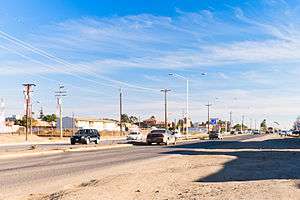San Quintín, Baja California
| San Quintín | |
|---|---|
 | |
 San Quintín Location in Mexico | |
| Coordinates: 30°33′37″N 115°56′33″W / 30.56028°N 115.94250°WCoordinates: 30°33′37″N 115°56′33″W / 30.56028°N 115.94250°W | |
| Country |
|
| State | Baja California |
| Municipality | Ensenada |
| Area | |
| • Land | 14,263 sq mi (36,941 km2) |
| Elevation | 92 ft (28 m) |
| Population (2010) | |
| • City | 4,777 |
| • Urban | 4,777 |
| Time zone | Northwest US Pacific (UTC-8) |
| • Summer (DST) | Northwest (UTC-7) |
San Quintín is a coastal town on the west coast of the Mexican state of Baja California, in the municipio of Ensenada, some 190 km (118 mi.) south of the city of Ensenada on Mexican Federal Highway 1. The town is also in the middle of an important agricultural area, especially for growing strawberries and tomatoes. The largest nearby locality is Lázaro Cardenas, home to 16,294 people as of the 2010 census. The whole area (6 localities) houses roughly 25,000 people, up from 20,000 in 2000. This is the largest population cluster south of Ensenada within the state.[1]
The coast also has many sand dunes, and is a popular place for off-road vehicles.
The town is on the west coast of the central Baja California Peninsula, near the Bahía de San Quintín, 300 km (187 mi) south of the San Ysidro–Tijuana international border along Federal Highway 1.
The Misión Santo Domingo de la Frontera lies 20 km north of San Quintín.
History
In the 1880s, a British land company with plans for a wheat empire purchased much of the San Quintín area from the US–based International Land Company; at the time, ILC owned most of northern Baja. In response to promises of agricultural wealth, around a hundred English colonists purchased subdivided land tracts from the parent company, planted wheat, and constructed a gristmill. For flour transportation, the English built a pier on inner Bahiá San Quintín and began constructing a railway to link up with the Southern Pacific tracks to the north in California. Thirty kilometers of track were laid, including a rail causeway from the west bank of inner Bahiá San Quintín, before the colony failed. A 17-ton, six-wheeled locomotive still lies underwater at the mouth of the bay, the remains of a loading accident for the aborted railway.
A drought devastated one of the first wheat harvests, and by 1900 all the colonists abandoned San Quintín.
Remnants of the gristmill, the railroad causeway, the pier, and an English cemetery still stand along the perimeter of the inner bay. The English names on the cemetery's heavily weathered wooden crosses have faded from sight, and more recent Mexican graves are beginning to crowd out their neglected English counterparts.[2]
Recently there has been foreign (especially Chinese) investment in San Quintin for the development of shellfish harvesting and export (especially abalone). A tourist hotel is also planned.
A new abalone farm is under construction out at the beach west of town in La Chorera. They are working with both state and federal agencies to reestablish the depleted abalone population. [3]
On October 28, 2015 residents voted 17,580 to 7,548 in favor of San Quintin becoming its own municipality By December 1, 2016 San Quintin was expected to separate from the municipality of Ensenada and become the state's sixth municipality.[4] The agricultural plain roughly 50 kilometers from Camalu to Vicente Carranza, recorded a total of roughly 80,000 people in 2010.
Climate
The temperatures tend to run warmer in summer and cooler in winter compared to San Diego, but out along the Pacific Ocean coastline about 10 miles west of San Quintin, the climate is virtually identical to San Diego's weather, year-round.
Towns
Lázaro Cárdenas, Baja California
- Colonia Vicente Guerrero
- a town north of San Quintín. It is located at (30°43′33″N 115°59′20″W / 30.72583°N 115.98889°W) (population 11,455)
- El Socorro
- A small town between San Quintín and El Rosario. It is located at (30°18′57″N 115°49′10″W / 30.31583°N 115.81944°W) (population 7). In the vicinity of this town was a salt marsh area which was the home of the likely extinct Tule Shrew and the San Quintin Kangaroo Rat.
Transportation
By land, San Quintín is communicated by the Federal Highway 1, which runs from Cabo San Lucas to Tijuana. By air, the San Quintín Valley is served by severals airstrips:
- Campo de Lorenzo Skypark
- Cielito Lindo.
- El Buen Pastor Airstrip
- El Pedregal.
- Los Pinos.
- Rancho Magaña.
The San Quintín Airport is the only paved airstrip in the valley, but is a military field, so it is used for military aviation purposes only. The closest airports of entry are Ensenada and Tijuana.
Media
XEQIN-AM, a government-run indigenous community radio station that broadcasts in Mixtec, Zapotec and Triqui, is based in San Quintín. The Coatecas Altas Zapotec dialect is spoken in the surrounding areas.[5]
References
- ↑ "Baja California (Mexico): Municipalities & Localities - population statistics and maps". Citypopulation.de. 2011-03-07. Retrieved 2014-07-23.
- ↑ "SAN QUINTIN History Overview - San Quintin, Baja California, Mexico". Bajaquest.com. Retrieved 2014-07-23.
- ↑ Abalone restoration project at La Chorera
- ↑ Colon, Brenda (2013-06-29). "Baja California deems San Quintin it s own City - Noticias". SanDiegoRed. Retrieved 2014-07-23.
- ↑ "Coatecas Altas Zapotec (zca)". Summer Institute of Linguistics in Mexico. Retrieved 2014-03-11.